Pest Information
Nardy Pest Control
We're Your Local Pest Experts
When you hire Nardy Pest Control to tackle your pest problems, you'll receive customized treatment programs designed to remove pests from your property for good. To answer any questions you have regarding common pests in the area, we've put together the resources below. If you have additional questions, please ask us during your upcoming service. If you need to schedule a free estimate, please give us a call today!
Ants
-
Ants - An Overview
These highly social insects live in colonies that consist of a dozen to several million individuals. The most seen ants are the sterile, wingless, female workers. Reproductive queens and males usually have wings. The second, or second and third, segments of the abdomen are constricted to form a distinct "waist." This waist may have either bumps or spiny processes. Most ants are red-brown or black in color, but yellow and green species also occur. Ants protect themselves by biting or stinging, or by spraying formic acid.
-
Life Cycle
After mating, males die, and queens shed their wings. Typically, a single queen lays all a colony's eggs. As the colony grows, workers take away and protect the eggs, and then care for and feed the hatched young. If a protein diet is fed to female larvae, they become reproductive.
-
Occurrence
Worldwide. In all habitats.
-
Remark
Ants are significant predators or herbivores in most habitats. Much more animal flesh, for example, is eaten by ants in African savannas than by lions, hyenas, and other carnivores. Some species, such as the leaf-cutter ants and the Fire Ant, can be serious crop pests.
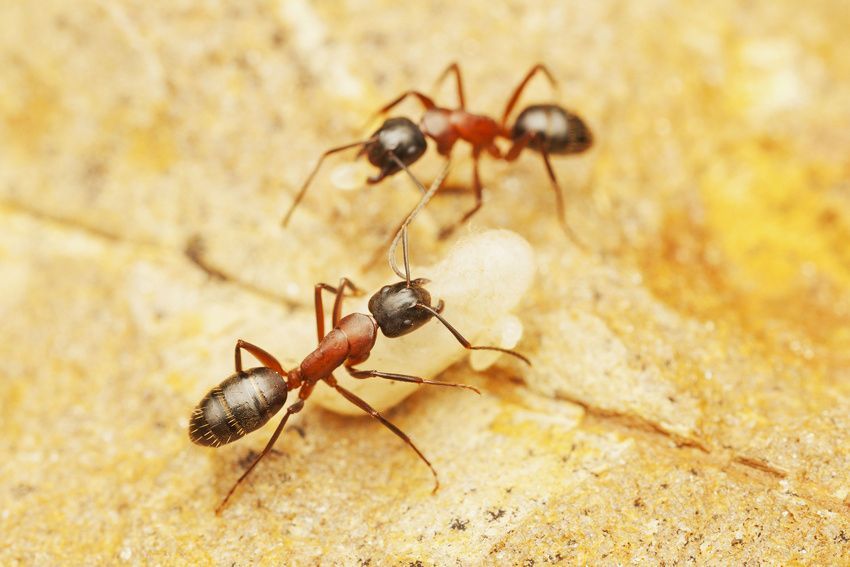
Bees and Wasps
-
Bees and Wasps - An Overview
The Order Hymenoptera contains 91 families and 198,000 species. Most members of the order have two pairs of membranous wings, joined in flight by tiny hooks. In all species except the sawflies, the first abdominal segment is fused to the thorax, while the second and sometimes the third segments are narrow and form a waist. Gender is determined by haplodiploidy, a process in which fertilized eggs produce females and males arise from unfertilized eggs.
-
Honeybees and Their Relatives
The most familiar members of this family are the stout, very hairy bumblebees, and the smaller, more slender honeybees. Most females have a special pollen basket (corbiculum) on the outside of the hind tibiae. Coloration is highly varied.
-
Life Cycle
These bees are social and live in colonies consisting of an egg-laying queen, males (drones), and sterile worker females who find food and look after the young. Bumblebees form small colonies under or on the ground. The nests in which they lay their eggs are made of grass with wax brood cells. Honeybee colonies compromise a queen, up to 2,000 males, and thousands of workers. The nest is an array of double-sided wax combs divided into hexagonal cells for rearing young and storing pollen and honey. Workers use a dance language to convey the distance, quality, and direction of food.
-
Occurrence
Worldwide, except in sub-Saharan Africa. Bumblebees are very common in northern temperate regions. In well-vegetated, flower-rich habitats.
-
Remark
In addition to providing honey, wax, and other products, these bees pollinate most of the world's plants.
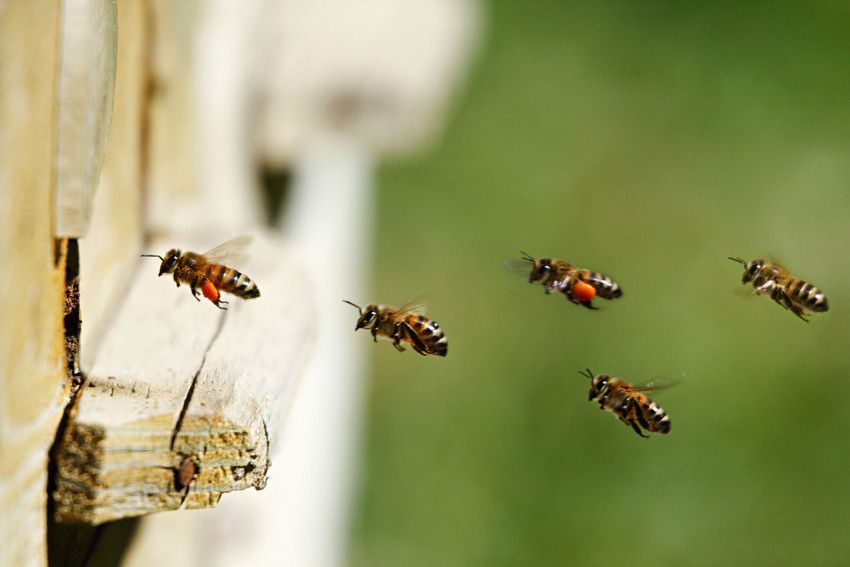
Beetles
-
Beetles - An Overview
About one in three insects in existence today is a beetle, and they have successfully colonized every sort of habitat. They range from tiny insects less than 1/32 in. in length to tropical giants measuring 7 in. Although beetles vary enormously in both shape and coloration, a major distinguishing feature is their toughened forewings, also known as elytra. These hard forewings protect the larger, membranous hindwings that are folded underneath.
-
Blister Beetles
Also called oil beetles, adults produce cantharidin, an oily fluid to deter predators that can blister human skin. Most species are soft, leathery, and black or brown with red or yellow marks. Some are metallic. Most are long and parallel-sided; a few are oval. The elytra vary in length.
-
Life Cycle
Blister beetles' eggs are laid in soil. The mobile, first-stage larvae locate and eat the eggs of grasshoppers or bees. Adults are herbivorous.
-
Occurrence
Worldwide, except in New Zealand, mainly in warm, dry areas. On flowers and foliage.
-
Remark
Some species are crop pests.
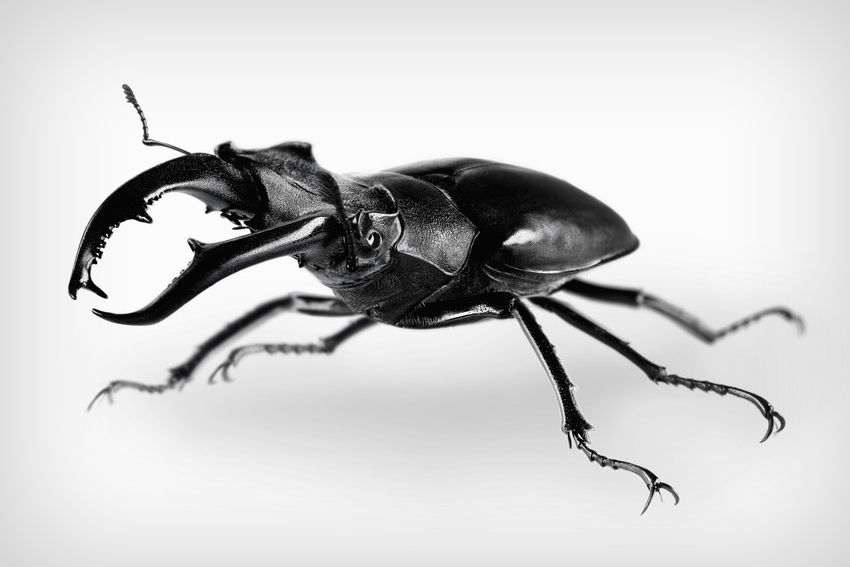
Booklice and Headlice
-
Lice - An Overview
Parasitic lice are flattened-looking insects, wingless, living permanently on the bodies of birds and mammals without killing them. Their mouth parts are used for biting skin, feathers, or fur but in the sucking lice, they are used exclusively for feeding on blood. The legs are short and are often modified for clinging onto either fur or feathers. Different lice are linked with specific hosts, such as the species with distinct mouth parts that are found only on warthogs and African elephants. Many lice are also restricted to certain areas of the body, so more than one species can inhabit a host at the same time.
-
Human Lice
Human lice are small, pale, and elongate, with short, strongly clawed legs for gripping their hosts. The small head bears distinctively dark eyes. The human louse, Pediculus humanus, also occurs on some monkeys.
-
Life Cycle
The body louse lives and lays eggs in the fibers of clothing, whereas the head louse lives entirely in the hair and glues its eggs (nits) to hair.
-
Occurrence
Worldwide. On humans, apes, and monkeys.
-
Remark
Outbreaks of head lice are common among young children. Resistance to insecticidal shampoos is developing and regular washing and fine combing is just as effective. Up until WWII, many more soldiers died of louse-borne epidemic typhus and relapsing fever than were killed in battle.
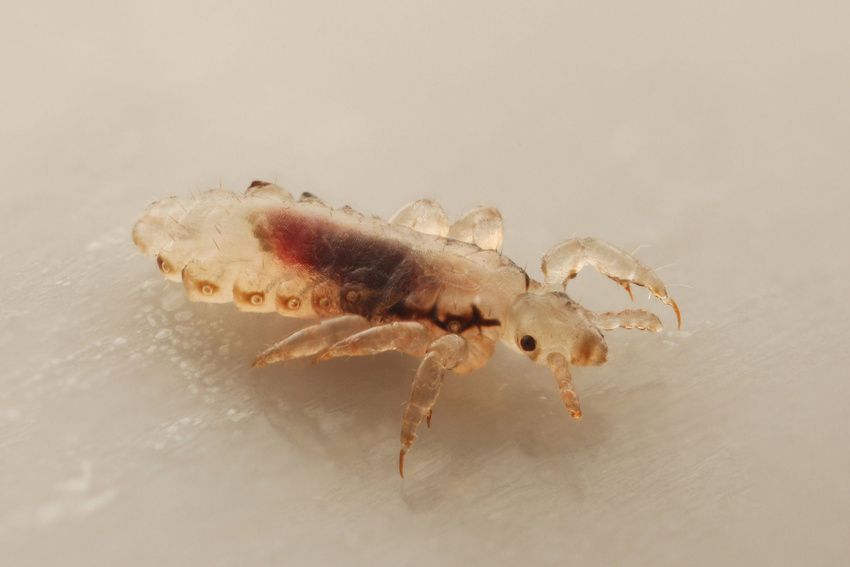
Centipedes and Millipedes
-
Centipedes and Millipedes - An Overview
Most millipedes are dull in color and are slow-moving, with tough, cylindrical bodies, strong mandibles, and seven-segmented antennae. The first four trunk segments have no legs; the other segments bear two pairs of legs. Although the common name implies that they have 1,000 legs, most have far fewer, and none has more than 750. Centipedes are long and usually flat, with a head that bears mouth parts and segmented antennea. the trunk has at least 16 segments, most of which carry a pair of legs, the last being the longest. Usually yellow or brown, the body may be green or red tinted and is covered with fine sensory hairs.
-
Scutigerids
These short centipedes are brown with paler markings. They have 15 pairs of very long legs. Those at the rear are much longer than those at the front. The body is kept straight by rigid overlapping "plates." The round head bears large compound eyes.
-
Life Cycle
Females lay one egg at a time — on the ground, in crevices, and among debris — and show no brooding behavior. Newly hatched young have seven pairs of legs and gain a leg-bearing trunk segment at each molt.
-
Occurrence
Worldwide, year-round in warmer climes and in the north during the summer months. In various habitats, including buildings and caves.
-
Remark
The house centipede can run at 16 inches per second.
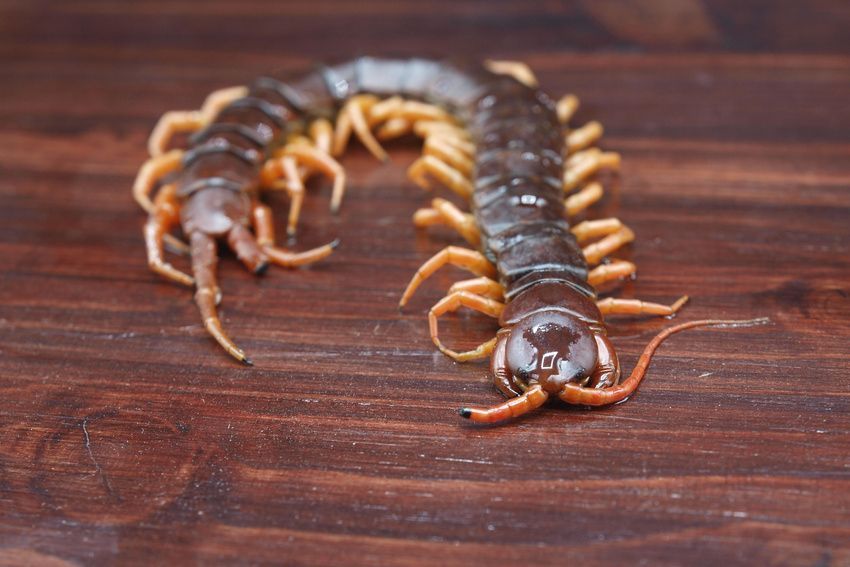
Crickets
-
Crickets - An Overview
The 28 families and 20,000 species of crickets, grasshoppers, and their relatives form the order Orthoptera. They have chewing mouth parts and hind legs that are adapted for jumping. Most species have toughened forewings to protect the larger hind wings. These insects are found in a range of terrestrial habitats. Singing is common, usually by males to attract mates.
-
True Crickets
These insects are slightly flat in shape, with rounded heads, and long, threadlike antennae. When present, the wings are folded flat over the body. Most are various shades of brown or black. Males sing mating songs using ridges at the bases of the forewings. In most females, the ovipositor is conspicuous and either cylindrical or needlelike.
-
Life Cycle
Eggs are laid in damp soil, singly or in masses. The carnivorous species known as tree crickets lay their eggs in small groups inside plant tissue. There are up to 12 nymphal stages.
-
Occurrence
Worldwide. In woods, meadows, scrub, and grassland. Most species are ground-living.
-
Remark
Some species are renowned for their songs, and in certain countries are kept in cages, as pets.
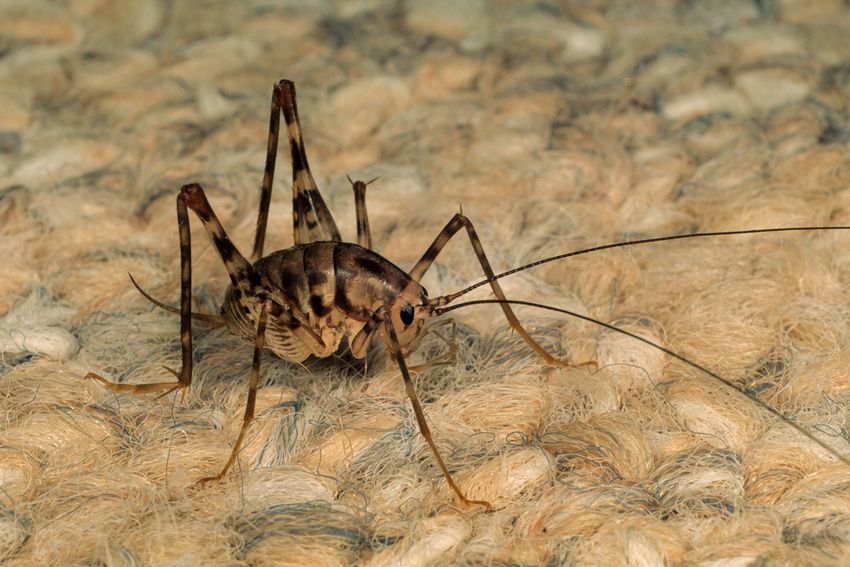
Earwigs
-
Earwigs - An Overview
Earwigs are relatively flat insects and have short, veinless forewings that protect the large, fan-shaped hindwings. The abdomen is mobile and telescopic, with a pair of force-like appendages that are usually straight in females and curved in males. Earwigs molt up to 5 times. Apart from increasing in size and gaining antennal segments with each molt, they look like their parents. Earwigs like confined spaces. Their name may refer to the popular belief that they enter human ears (they rarely do), or to the shape of their hindwings.
-
Common Earwigs
These typically slender earwigs vary in appearance but are usually dark brown or blackish brown, with paler legs and threadlike antennae. The abdominal forceps of the male earwigs are highly curved, whereas those of the females are relatively straight.
-
Life Cycle
Females usually lay eggs in soil under rocks or bark. They guard the eggs against predators and lick them clean to prevent any fungal growth. Apart from plant matter, the diet may include small caterpillars, aphids, and other insects.
-
Occurrence
Worldwide. In leaf litter and soil, under bark, or in crevices.
-
Remark
These insects can be pests of crops or garden plants.
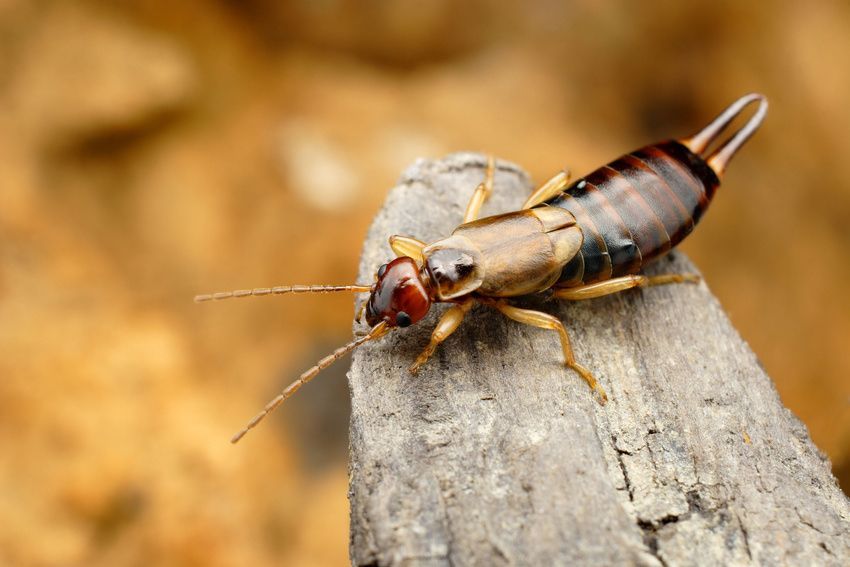
Fleas and Mites
-
Fleas - An Overview
There are 18 families and 2,000 species of fleas. These brown, shiny, and wingless insects have tough, laterally flattened bodies covered with backward-pointing spines and bristles. The enlarged hindlegs are part of a unique jumping mechanism involving energy storage in rubberlike pads of protein. Fleas have specialized mouthparts for sucking blood. They are ectoparasites, living on the outside of a host animal and feeding on it without killing it. Less host-specific than parasitic lice, some fleas are found on over 30 host species — mostly terrestrial mammals but also birds. The larvae do not suck blood, but scavenge on the excrement of adult fleas, detritus, and dried blood.
-
Common Fleas
This family looks typical of its order and may have bristle-combs on its pronotum and cheeks. Common fleas are ectoparasitic on humans and a wide range of other mammals, including dogs, cats, and rabbits.
-
Life Cycle
Eggs are dropped in hosts' nests or burrows. Adults can survive for a long time without a blood meal. Emergent fleas remain in their cocoon until they sense a host's presence.
-
Occurrence
Worldwide. On mammalian hosts in a wide range of habitats.
-
Remark
Many species spread disease. The Dog Flea carries a tapeworm that affects dogs, cats, and humans. The bacterium that caused the Bubonic Plague in medieval Europe was carried by various types of rat fleas.
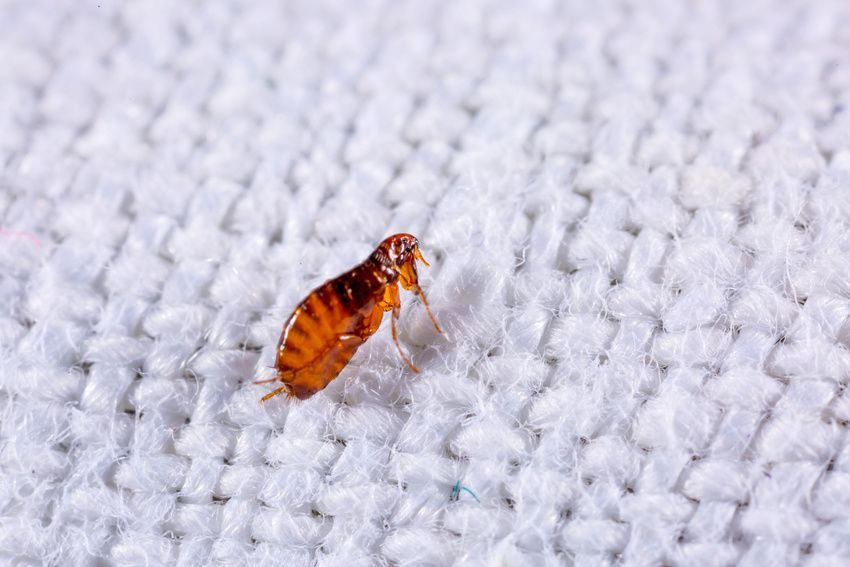
Mice
-
Mice - An Overview
In a house, barn, or storage building, mice are a big problem. They eat and contaminate grains and other foods. House mice chew or shred anything that they can get their teeth on, including furniture, clothing, and electrical wires. Chewed electrical wires can sometimes start fires and cause electrical shorts in homes. Mice gnaw holes in walls, floors, and baseboards, and can even weaken wood structures. Like Norway rats, mice can also spread many diseases. Mice cost homeowners and farmers millions of dollars in damages every year.
-
Appearance
The back of the deer mouse varies in color. Their backs can be many shades of brown and some mice are pale gray. The underparts are usually white, including the underside of the tail, which tends to be as long as the body. It is a very small animal and weighs under 1 ounce. The total length of the body, including the tail ranges from 4 to 8 inches. The ears are quite large and are covered with fine hairs.
-
Habitat
The deer mouse is found throughout North America. It likes dryland areas and is not found where the ground is continually wet. One study found that the female deer mouse was better at selecting home ranges with good food sources than the male mouse. Perhaps the female is more selective because she requires an excellent diet when raising her young. To produce the milk needed to feed the babies, the female must eat about three times the amount of food that she would normally require. Adults are usually solitary except during the mating periods. In winter, however, the animals sometimes share nests and sleep together for additional warmth.
-
Diet
The deer mouse is an omnivore, which means it eats both plants and animals. In the summer, their diet consists mostly of seeds and fruits, but insects are also an important food source. Its favorite foods include raspberries, blackberries, blueberries, spiders, and beetles.
-
Enemies
Mice are a source of food for many animals and therefore have many enemies. Only about five percent of the babies born live past the first year of life. Some enemies of the deer mouse are owls, weasels, foxes, snakes, skunks, minks, raccoons, bears, coyotes, and wolves.
-
Life Cycle
It's difficult to say exactly how many litters the female deer mouse has each year. It varies from year to year and depends upon many things such as the weather and the local food supply. On average, the deer mouse has about four litters each year, but when conditions are very good, it may have up to 14 litters in a single year. Each litter normally consists of about four to six babies, but a single litter may have as many as 12 or 13. In a very good year, a deer mouse that has 12 litters will produce 72 new offspring.
-
Special Features
The male deer mouse plays an important role in the care of the babies. This is quite unusual because in many animal species the male plays no part in the raising of the young. Although the male is not present when the young are born, it does return to care for the babies. The male assists in the grooming of the young, helps with the nesting site, and teaches the young mice how to explore for food near the nest.
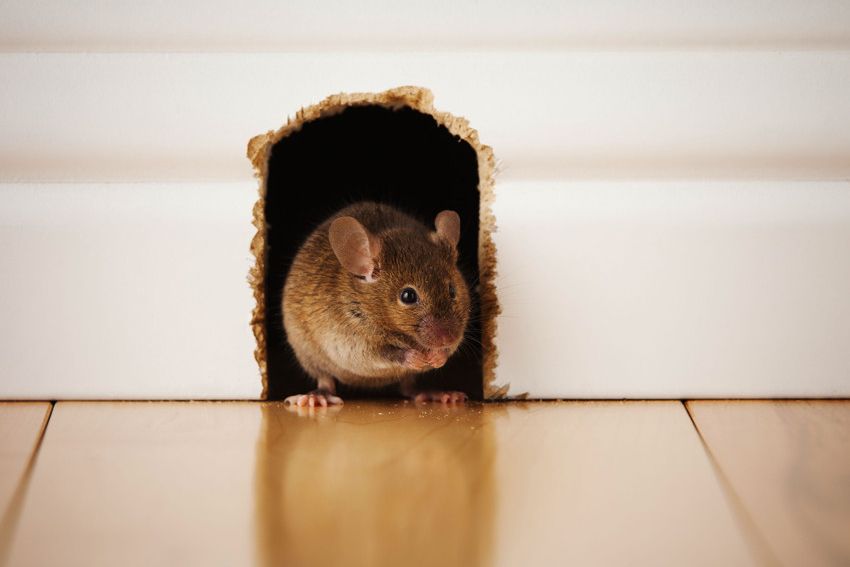
Moles
-
Moles - An Overview
Moles are tiny, furry mammals that look like mice except for their long, pointed noses. They are the smallest of all mammals. Its Latin name, "aquaticus,” refers to its slightly webbed toes.
-
Appearance
The mole measures between 3 and 10 inches long and has a long, flexible, nearly hairless snout, short neck, and a short tail of between 1 and 2 inches. It has no visible eyes. Its forefeet are wider than they are long, and its palms point outward. It digs by spading with its forefeet, one and then the other, shoving soil under its body. Its hind legs then push the soil back into the tunnel. Like most moles, the eastern mole digs deep tunnels to make a nest or a shelter, and several other tunnels that run just under the surface of the ground. These often appear as low ridges across lawns or flat areas. To dispose of the soil from its deep tunnels, the eastern mole pushes up small mounds called mole hills. Near its shelter or nest, the eastern mole even digs special rooms to get rid of body waste.
-
Habitat
The eastern mole is the most common mole in the Eastern United States. It lives in open woodlands, pastures, lawns, and gardens. It prefers well-drained, loose soil. The eastern mole spends nearly all its time underground and is most active at dawn or dusk.
-
Diet
Moles burrow all or most of their lives through the soil, looking for food. They eat almost any insect, worm, or bug found in or on the ground. If a mole goes for more than a few hours without food, it will starve to death. This occurs because, except for a few pauses, it is moving all the time. It uses a lot of energy and must eat to get more energy. Even at night, a mole does not stop looking for food. It must eat more than its own weight in food each day to stay alive. It eats mostly earthworms but occasionally eats the larvae or adults of insects found in the soil also. Like most moles, it finds its food using its flexible, hairless snout and sensitive whiskers, which can detect the slightest vibration or movement in the soil. Grubs are a favorite food for moles to eat.
-
Enemies
The eastern mole has few natural enemies. It usually dies due to accident or disease.
-
Life Cycle
Because of their low death rate, eastern moles mate and have one litter of two to six young a year in the spring. The young are born only four to six weeks after mating and are born blind and hairless. To mate, the male seeks out the female in her burrow, a hollow earth chamber, under a log, stump, or large rock with a floor of dried grass or shredded leaves. The young are born in this nest or onto the dirt floor near it and spend just a few weeks living off their mother's milk before they can go off on their own. The young can take care of themselves after a month and can have young of their own in the following spring.
-
Special Features
Because it lives underground, people seldom see the eastern mole. It sometimes ruins lawns with the ridges from its surface burrows. Poisoning or trapping is the only way to get rid of this creature. Soaking the ground heavily with water might help to chase it away as it doesn't like damp or wet soil. Sometimes the sight of ridges is a sign that some insect larva that might ruin the grass roots is present and attracting the mole.
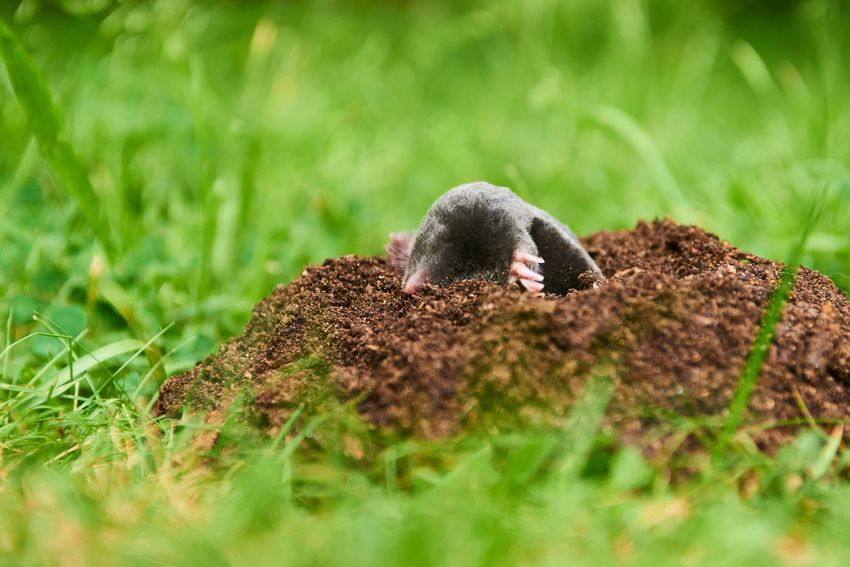
Mosquitos and Gnats
-
Mosquitoes - An Overview
Mosquitoes and gnats are part of the order Diptera, just two insects in an order that contains 130 families and 122,000 species. These insects have just one pair of wings; the hind wings are reduced to small, club-shaped balancing organs called halteres. Some are wingless. Two-winged flies are vital pollinators, parasites, predators, and decomposers in all kinds of habitats. Many, however, damage crops or carry diseases that have a huge impact on animals and humans.
-
Mosquitos
The body of these delicate, slender flies is covered with patterns of white, gray, brown, and black scales. Some tropical species are brightly colored. The long, narrow wings have scales along the veins and edges, and the mouthparts are very long, slender, and piercing.
-
Life Cycle
Eggs are laid on the surface of the water, either singly or in groups of 30 to 300. The larvae are saprophagous or eat other mosquito larvae and obtain air from the water surface through an abdominal siphon. Adult females suck the blood of vertebrates but also take plant fluids and nectar; the males feed on plant fluids, nectar, and honeydew. The life cycle usually lasts fewer than three weeks.
-
Occurrence
Worldwide, especially in warm areas. Adults are common near woodland, and larvae are found in virtually any body of freshwater, from a rain-filled tree hole, or water-butt to a lake.
-
Remark
The females of many species carry organisms that cause serious diseases in animals and humans. These diseases include malaria, yellow fever, dengue fever, filariasis, and encephalitis. Malaria is caused by protozoa that belong to the genus Plasmodium and that are parasites of blood. Worldwide, one person dies of malaria every 12 seconds. Despite massive efforts to control the disease, it continues to be a serious, and growing, problem.
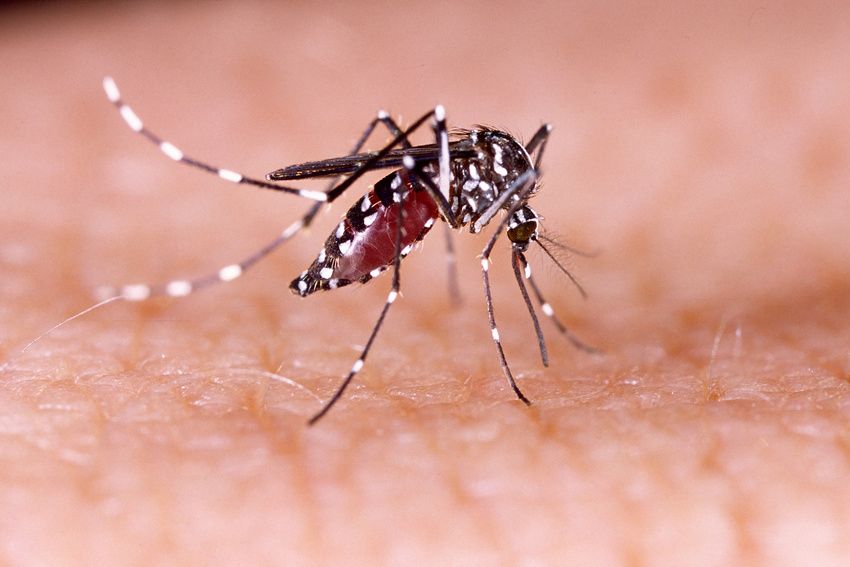
Moths
-
Moths - An Overview
There are no specific differences between moths or butterflies. Moths, however, usually fly at night and butterflies during the day, while butterflies have club-ended antennae which moths usually lack. Both groups have tiny, overlapping scales on the body and wings and multisegmented antennae. Their mouthparts usually form a proboscis for taking nectar and other liquids.
-
Tiger and Ermine Moths
Most tiger moths are heavy-bodied and hairy, often brightly colored in various combinations of black, red, yellow, and orange, which warns off predators. Ermine moths tend to be pale or white, with small black markings. This family also includes the slender, dull footmen moths.
-
Life Cycle
Eggs are laid on and around host plants. Many caterpillars in this family eat a wide range of plant matter and most feed at night. They are very hairy, and many species are poisonous because they eat leaves of plants such as potato and laburnum, which contain toxic substances. Footmen species feed by day, and their smooth caterpillars eat lichens.
-
Occurrence
Worldwide. In well-vegetated areas where host plants occur.
-
Remark
Some are significant forest and orchard pests.
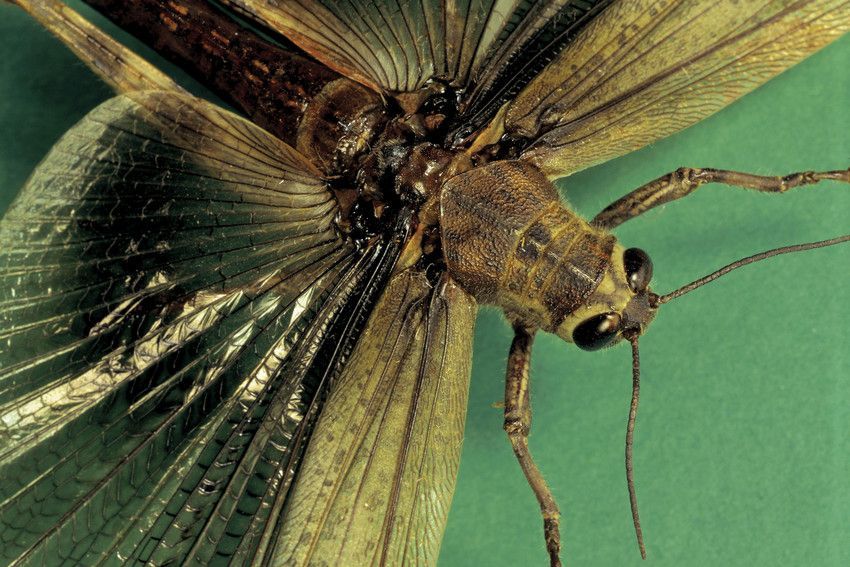
Pillbugs and Sowbugs
-
Pillbugs and Sowbugs - An Overview
The Order Isopoda consists of 100 families and 10,000 species of crustaceans. Most are marine, however, 3,800 species live in terrestrial habitats. They are collectively known as woodlice and have segmented bodies with seven pairs of similarly shaped and sized legs. The female carries the eggs inside a brood pouch, which is located beneath the abdomen. The young are kept in this pouch for a while after they hatch out. Most woodlice favor damp and cool conditions, although some have become adapted to a wide range of habitats, including extremely dry regions. Some woodlice have camouflage coloring that blends in with their background.
-
Sowbugs
The smooth or warty body surface of these woodlice is usually either gray or grayish brown, with various other markings. Some species or Sowbug have narrower bodies and are able to run quickly.
-
Life Cycle
The females carry the eggs in their brood pouch until they hatch.
-
Occurrence
Worldwide, but mainly in temperate regions. Found mostly in leaf litter and debris.
-
Remark
As with all woodlice, nitrogenous wastes are excreted as ammonia gas — not as urine. This gives large colonies of woodlice a characteristic smell.
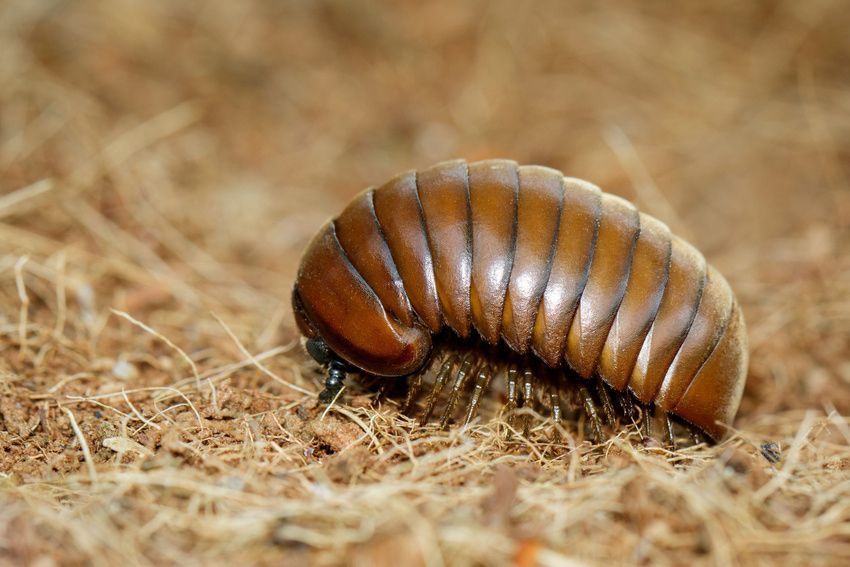
Raccoons
-
Raccoons - An Overview
The name "raccoon" comes from the Algonquin Indians word Arakun, which, when translated, means that which "scratches with his hands."
-
Appearance
The raccoon is a medium-sized animal with a long and thick coat. It has a bushy tail, slender muzzle, black mask on its face, and large pointed ears. Though its color varies from raccoon to raccoon (and with age), the overall color is a dull yellowish grey or greyish brown. The face is whitish with a black mask running from the cheeks to the eyes. The head and body measure between 1 1/5 and 2 1/2 feet with a tail measuring between 8 and 12 inches long. The adult raccoon weighs between 10 and 30 lbs.
-
Habitat
The raccoon is widely found throughout the Eastern United States and Canada. It is found along streams and lakes, near wooded areas and rock cliffs.
-
Diet
The raccoon is an omnivore with a varied diet of both plants and animals. In the spring, their diet consists mainly of small animals, such as crayfish, young muskrats, squirrels, rabbits, the eggs of ducks, red-winged blackbirds, grouse, pheasants, and quail. From the water, the raccoon eats salamanders, small fish, tadpoles, clams, and aquatic insects. In summer, the raccoon's diet is at least 75 percent plants. All kinds of berries, along with such fruits as plums and peaches, are eaten where and when available. Peas, potatoes, and immature corn are taken from gardens or farmers' fields. Field mice, insects, grains, and songbirds are also eaten.
-
Enemies
The raccoon has few natural enemies other than man which hunt and trap them for their pelts. Many raccoons are also killed by cars while they are out at night foraging for food.
-
Life Cycle
Raccoon males seek out females in January and February, and young are born about 63 days after mating. In the Northeast United States, cubs are usually born in April and May. The males have no part in raising the young. The young cubs' eyes open between 18 and 23 days, and then they leave the den at about ten weeks and begin to forage for food with their mother. Cubs begin to leave the home range in the fall, however some cubs might remain with the mother until the following spring.
-
Special Features
The raccoon is one of the most commonly seen animals in the Northeast United States and Canada. While most active at night, they can sometimes be seen sunbathing in a tree on a bright sunny day. The raccoon uses its front paws as hands almost as skillfully as monkeys do. Contrary to popular belief raccoons do not wash their food before eating it.

Rats
-
Rats - An Overview
The Norway rat probably first came from central Asia. It made its way on trading ships into Europe during the Middle Ages during which it played a key part in spreading the Bubonic Plague through the fleas it carried. The Norway rat prefers to live near people. There never were more of these rats in Norway than in other parts of Europe or Asia, but the name stuck. Some science books say that it was first collected for scientific studies in Norway.
-
Appearance
The Norway rat is also called the common rat, sewer rat, brown rat, and water rat. In the wild it is brownish gray on its back, and greyish on its belly, with a long scaly tail 5 to 10 inches long. It has small bulbous eyes like most rodents and large ears. They are usually 1 to 1 1/4 feet long and weigh anywhere between 1/4 and 3/4 lb. It is not native to North America but came over from Europe on ships along with settlers. It lives in all parts of the Northeastern United States and Canada, mostly where people live. It usually lives in buildings and sewers during the winter but builds its nests in fields where food and crops grow during the summer.
-
Habitat
The Norway rat makes a network of interconnecting tunnels 2 to 4 inches across and up to 1.5 feet deep and 5 feet long. It usually lives alone with one or more rooms for nesting or eating as they are territorial; however, they can also be found living with other rats in a maze of tunnels, nests, and rooms. It digs by cutting roots or other underground things that are in the way with its sharp incisors (front teeth), and then scrapes away loose dirt. It pushes the dirt under its body with its hind feet, then turns around and pushes the dirt down the tunnel with its head and forefeet. Rats can go through the hollow walls of houses, gnawing out wood and sheetrock.
-
Diet
The Norway rat adapts very well to all places where people live. It is omnivorous and eats anything people tend to eat and then throw away. In addition to "people food." It also eats insects, green plants, fruits, birds, rabbits, small snakes, mice, young pigs, soap, garbage, seeds, and grain. It kills chickens and eats their raw eggs as well. The Norway rat gnaws paper, wood, plastic, and cloth; however, it prefers grains, meats, and cheeses that contain much protein.
-
Enemies
The Norway rat has enemies which include the raccoon and cat. Of course, man is responsible for curbing the population of rats in cities and towns.
-
Life Cycle
If not controlled by man or natural enemies, the Norway rat can easily have a population explosion. A female can mate with a male just hours after giving birth, and mating goes on between males and females all year round. The 7 to 11 young per litter are born hairless and blind but can open their eyes at two weeks of age. They are well enough developed to leave the nest at three to four weeks of age; Females can breed at three months of age. In a litter, a rat can have 2 to 22 young, but 7 to 11 is much more usual. Few Norway rats live out their full three years. At two years of age, females stop breeding and males are not as interested in mating. A female can have up to 12 litters a year if conditions are very good, but usually has five.
-
Special Features
The Norway rat does have a use in science. Scientists breed the white rat for use in medical laboratories, and white rats also make good pets! They are generally free of disease, very tame, and clean. The white (or albino) rat cleans itself by grooming with its tongue and forefoot, and in this way, it is very similar to a cat. In addition to making a nice pet, they are also used to testing all kinds of food and medicine before they are given to people.
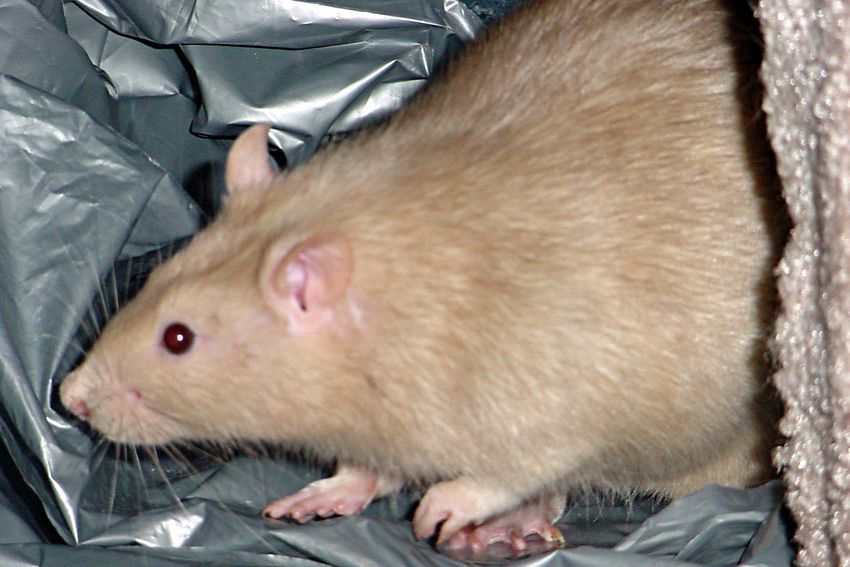
Roaches
-
Roaches - An Overview
Most cockroaches live in tropical regions. Less than one percent of them are pests, adapted to human habitats, thriving in warm, unsanitary conditions, and often carrying disease. Cockroaches mostly eat organic matter, including bird and bat guano. Their main defense against predators is that they are highly sensitive to vibration and can run fast, but some also spray or ooze toxic chemicals.
-
Wood Roaches
The wood roaches are the most primitive cockroaches and belong to a single genus: Cryptocercus. They are quite elongated and are shiny dark brown to black.
-
Life Cycle
Wood roaches live in small family groups compromising two adults and 20 nymphs. They tunnel through dead wood — sticking their eggs to the roof of the wooden chambers — and use special symbiotic protozoans in their gut to break down the wood and cellulose into sugars. Each time nymphs molt, they eat some of the group's droppings, thus reinfecting themselves with the protozoans.
-
Occurrence
North America and China. In dead wood in a variety of habitats.
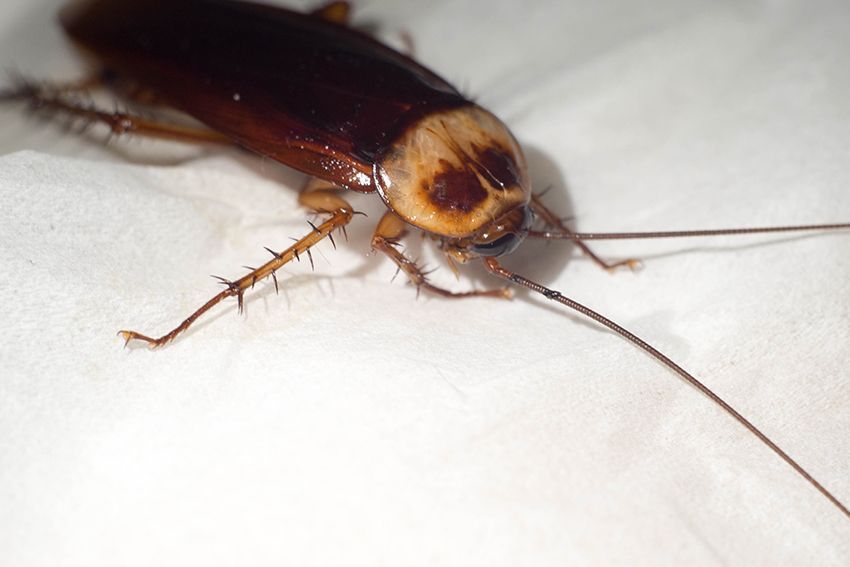
Silverfish
-
Silverfish - An Overview
The four families and 370 species of silverfish that make up the order Thysanura are primitive, wingless insects with elongated, flat bodies that may have scales on the surface. They have simple mouth parts and may have small, widely separated compound eyes or no eyes at all. Most species have no ocelli. The three abdominal tails are of equal length and the abdominal segments have projections called styles. Silverfish occupy a wider range of habitats.
-
Silverfish
The brownish bodies of these insects are tapered, slightly flat, and usually covered with either grayish or silvery scales. They have compound eyes but no ocelli. All silverfish are nocturnal. Some species favor cool, damp conditions, while others prefer warm, dry places.
-
Life Cycle
The females lay their eggs in cracks and crevices.
-
Occurrence
Worldwide, especially in warmer regions. In tree canopies, under stones, and in caves. Some inhabit houses or the nests of birds, ants, or termites.
-
Remark
Domestic species eat flowers, damp textiles, book bindings, and wallpaper paste.
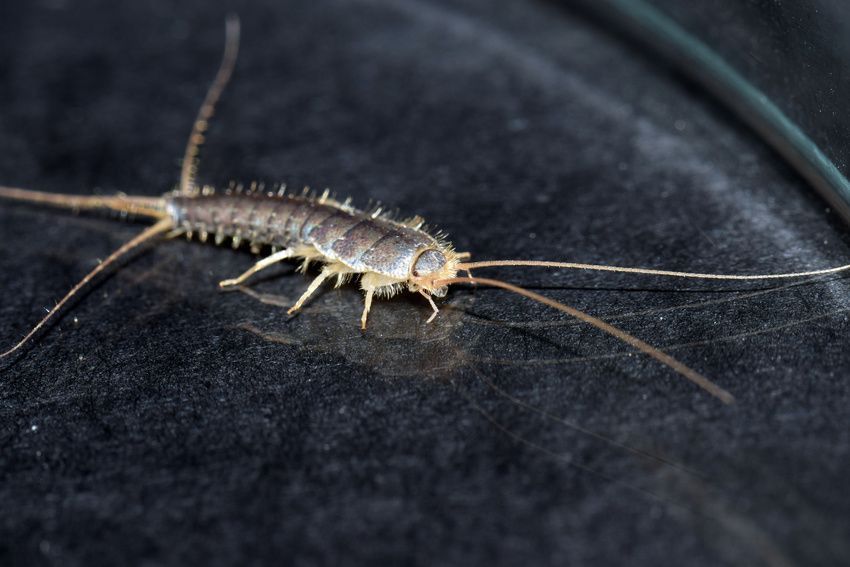
Spiders
-
Spiders - An Overview
Spiders are found in almost every terrestrial habitat, from deserts to mountain peaks. They cannot fly, but many are able to travel long distances by "ballooning" on silk threads. Most species have eight simple eyes, but some have six, four, two, or no eyes at all. The chelicerae have a hinged fang at the tip, and almost all species have venom glands. A spider's pedipalps are six-segmented and have a sensory function. There are four pairs of seven-segmented walking legs. The abdomen is not segmented and carries silk-spinning organs. When a spider feeds, the body tissues of its prey are dissolved by enzymes in the spider's digestive juices.
-
Daddy Long-Leg Spiders
The eyes of these spiders are arranged in two groups of three, with another pair in between. Typically, the carapace is very round. The legs are much longer than the body, giving a spindly appearance. Coloration is gray, green, or brown, with pale legs. The tarsi are very long and flexible. These spiders make tangled, irregular webs and quickly wrap trapped prey in silk before biting it.
-
Life Cycle
Females produce about 15 to 20 eggs, which they wrap in a silk bundle and carry in their mandibles until they hatch.
-
Occurrence
Worldwide. Many tropical species occur in caves or leaf litter. In temperate regions, many species live in the dark corners of buildings.
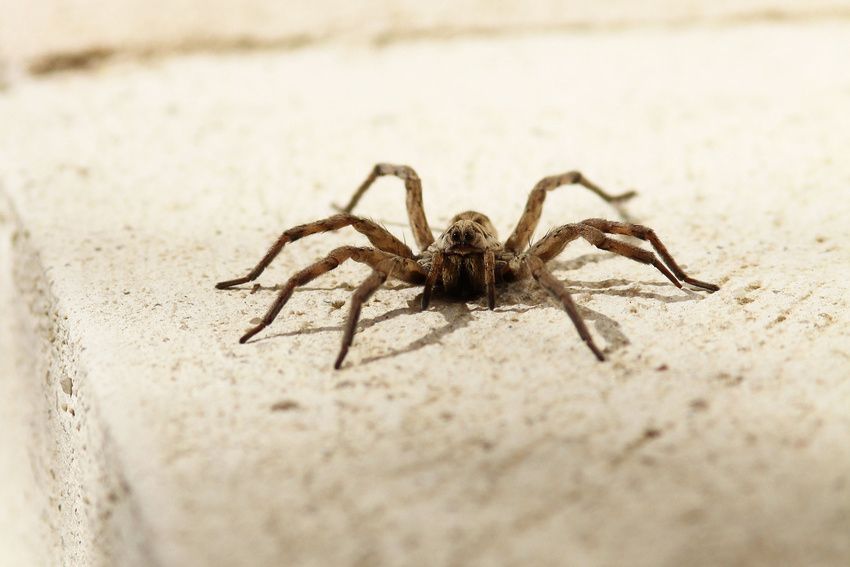
Squirrels
-
Squirrels - An Overview
When settlers first arrived in North America, they found the grey squirrel in large numbers. The squirrels were a problem to farmers because they would eat large amounts of seeds and grain, but the population slowly declined as the forest habitat was taken over by farms and as squirrels were killed to reduce the damage they were doing to the settlers' crops. In the early 1900's scientists were concerned that the squirrel might become extinct. Fortunately, the squirrel survived, and we can enjoy watching the small mammal in its daily activities.
-
Appearance
The grey squirrel is quite common in the Northeastern United States and Canada. It has grey fur on its back, and its underside has a soft white color. It also has a large, fluffy tail that is nearly as long as its body. Its body is anywhere between 8 and 10 inches long, and its tail is the same length. Its weight can vary from 6 ounces to 3/4 lb. In some locales, the grey squirrel can also be born with black fur.
-
Habitat
The home range of the grey squirrel is about one hectare. The males' home range is usually larger than the females,' and both like wooded areas that can supply sources of food, protection, and places to build dens. The grey squirrel is quite neighborly and shares its home range with other squirrels. Though this is not true of some squirrels, such as the red squirrel, which will attack and chase away other squirrels that enter their home range.
-
Diet
The diet of the grey squirrel changes throughout the year. In August when the nuts from trees such as the oak, walnut, and beech trees begin to mature, the grey squirrel eats all the nuts it can and stores the rest. Grey squirrels store large numbers of nuts underground, and in hollow tree stumps. They dig a hole about 2 to 3 inches deep and place a nut inside. They then push it down with their nose and cover it over with dirt using their feet. They usually store only one nut in each hole and can work very quickly. In only 30 minutes they can store up to 25 nuts! During the summer, the diet of the grey squirrel is made up of insects, flowers, mushrooms, pinecones, corn, and apples.
-
Enemies
The squirrel's natural enemies include the raccoon, opossum, and feral cat. Hunters do catch squirrels for their pelts, and many are also killed by automobiles.
-
Life Cycle
The young are born about 45 days after mating. They are born with their ears and eyes closed, have no hair, and must stay very close to the mother for warmth. They suckle milk from their mother, and in about five weeks, they are fully furred and can see and hear. They begin to take short trips out of the nest and after eight and nine weeks, they are weaned from their mother's milk. At about four months of age, the squirrels have established a home range and no longer rely on their mother. The male squirrel has no part in the raising of the young.
-
Special Features
The average life span in the wild is three to six years. In captivity, they can live to be 15 to 20 years!
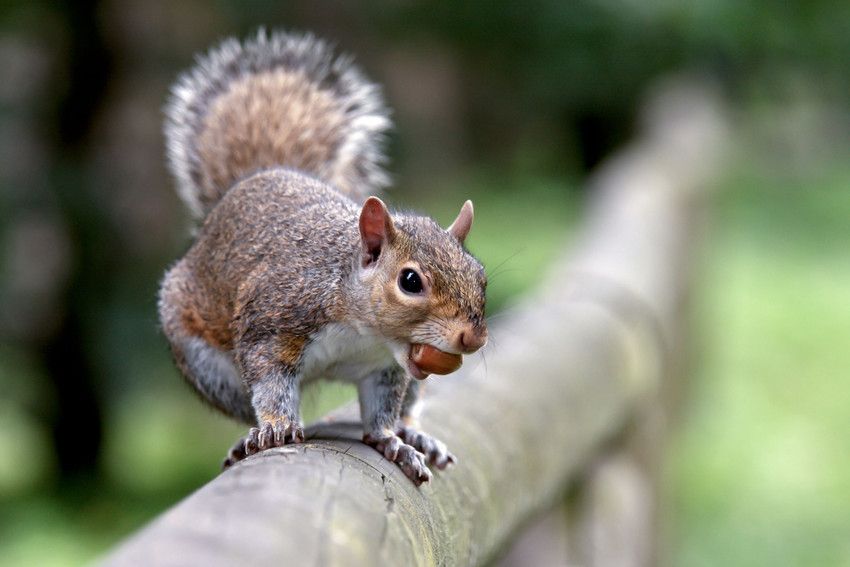
Termites
-
Termites - An Overview
The seven families and 2,750 species in the order Isoptera are never found more than 50 degrees north or south of the Equator. A typical termite is pale, soft, and wingless, with chewing or biting mandibles and short antennae, but the different castes within a colony have varying features. The reproductives, including kings and queens, have two pairs of long wings, short cerci, and round or oval heads. The sterile soldiers have proportionately larger heads than the workers. Eyes are often reduced or absent. Termites live in mud nests or vast underground mazes with huge ventilation chimneys above the ground. Most eat dead or rotting wood--this is the only order in which all families digest cellulose — and many attack crops or wooden buildings.
-
Subterranean Termites
The pronotum of all castes is rounded at the back and may, in some species, appear almost heart shaped. Soldiers have no eyes. Their coloration is cream or light to dark brown.
-
Life Cycle
Eggs are laid in the colonies, which are found either in soil or in damp wood that touches the ground.
-
Occurrence
Worldwide, in warm regions. In various habitats, in soil and wood.
-
Remark
Some species are timber pests. One North American species is such a serious pest that there are special building regulations to help prevent the damage it can cause.
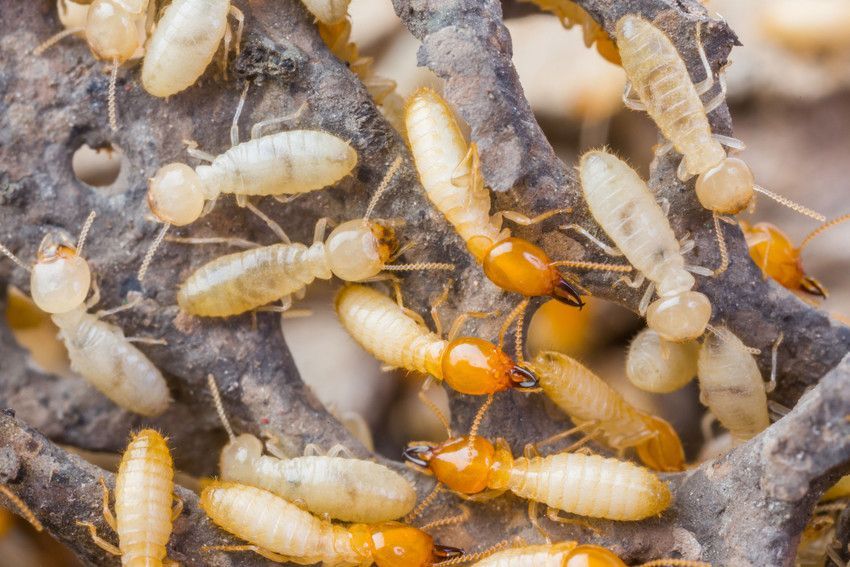
Ticks
-
Ticks - An Overview
Ticks and mites form the order Acari, a huge, diverse group of about 300 families and 30,000 species. They are found in every habitat, including aquatic ones, and have a wide range of lifestyles. Many are significant pests of crops and stored produce or parasitize humans and other animals. Most species are less than 1/32 inches long, although ticks can be much larger, especially following a blood meal. The body has no distinctive divisions, and the short abdomen has no segments. The mouthparts are carried on a special extension. The chelicerae are two or three segmented pincers or are adapted for piercing and sucking. Both the adults and nymphs have four pairs of six-segmented walking legs, although the first-stage larvae have only three pairs.
-
Deer Ticks
These flat ticks have a very tough, sometimes patterned plate on their back. In males, it covers the whole body; in females and immature ticks, it covers only the front half. The soft, flexible abdomen allows large blood meals to be taken from the animal hosts on which these ticks are found. Their coloring varies from yellow to red or black to brown. Some species are highly marked.
-
Life Cycle
After mating, a female gorges herself on blood and then drops off the host to lay a batch of eggs among vegetation. Six-legged larvae emerge, crawl up grass blades, and attach themselves to a passing host. A larva feeds for a few days and then drops off the host to molt into an eight-legged nymph. The nymph attaches itself to a host and feeds for several days before once again dropping off to molt into an adult.
-
Occurrence
Worldwide. In association with bird, mammal, and some reptile hosts.
-
Remark
Many deer ticks transmit disease and are serious pests of domestic animals such as cattle, sheep, horses, and poultry. Some also carry viral diseases that affect humans, including encephalitis, Lyme disease, tick typhus, and Rocky Mountain Spotted Fever.
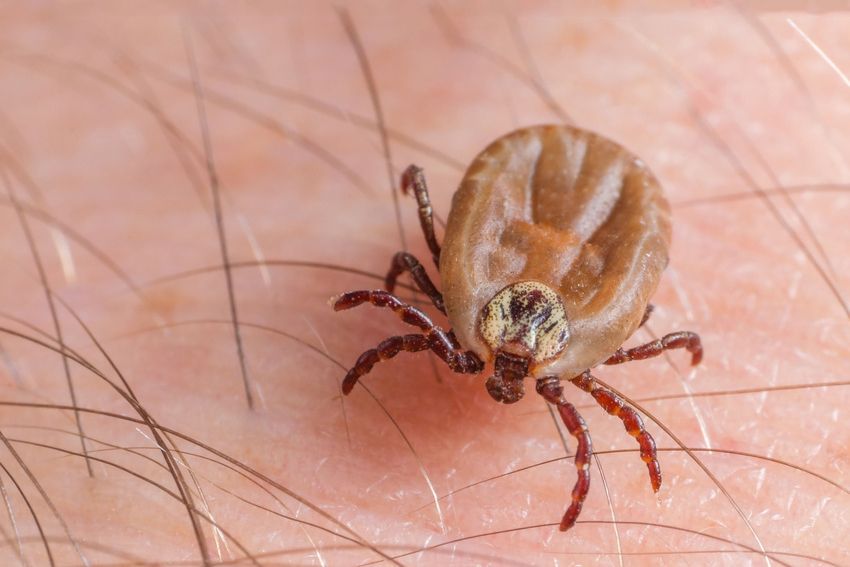
Voles
-
Voles - An Overview
The vole is 5 1/2 to 8 inches long including a tail 1.5 to 3 inches long. The tail of a vole is usually 1/2 its body length. Unlike a mouse, a vole has ears that are smaller and not easy to see. The nose or snout is more blunt and shorter than that of a mouse. It weighs just 1 to 3 ounces, heavier than a mouse of the same body length. The color of its upper side can be anything from yellowish brown or reddish brown speckled with black to blackish brown. Its underside is grey with silver-tipped hairs. Its feet are always dark.
-
Appearance
The mole measures between 3 and 10 inches long and has a long, flexible, nearly hairless snout, short neck, and a short tail of between 1 and 2 inches. It has no visible eyes. Its forefeet are wider than they are long, and its palms point outward. It digs by spading with its forefeet, one and then the other, shoving soil under its body. Its hind legs then push the soil back into the tunnel. Like most moles, the eastern mole digs deep tunnels to make a nest or a shelter, and several other tunnels that run just under the surface of the ground. These often appear as low ridges across lawns or flat areas. To dispose of the soil from its deep tunnels, the eastern mole pushes up small mounds called mole hills. Near its shelter or nest, the eastern mole even digs special rooms to get rid of body waste.
-
Habitat
The meadow vole lives in all parts of the Northeast United States, and resides in green fields, marshes, swamps, grassy glades of forests, and on high hills. It also lives in all evergreen or boreal forests in Canada except for Newfoundland and areas farther north. Voles live in all forests, at the edge of woodlands, and in uphill "heaths." Heaths are places where only grasses, mosses, and bushes grow. The vole usually builds a nest of grass in thick grass or under stones. Sometimes it uses the burrow left by another small mammal to hide its nest.
-
Diet
Voles eat plants. These include dwarf birch, blueberries, cranberries, soapberries, bearberries, mushrooms, and herbs. The herbs a vole eats include fireweed, baked apple, and cinquefoil. Voles will clip and pile twigs in caches to eat them later. The home range of the heather vole is about 0.8 hectares. It lives most of its life within that range.
-
Enemies
The enemies of the vole include the ermine, red fox, marten, owls, and hawks.
-
Life Cycle
Voles have a brief chase for a courtship, then the males and females will mate. After only 19 to 24 days, two to eight blind, hairless young are born. The young weigh only 2.4 grams and feed from eight teats on their mother's belly. Their eyes open at 14 days, and the young will stop taking milk from their mother at 17 to 21 days. Young voles are on their own at the age of one month. Females can mate when four to six weeks old. Males must wait until the following spring before they can mate. Females have two or three litters a year between May and September, most surviving for only a year. A few live for two or even three years.
-
Special Features
Voles do not hibernate. They build nests and latrines of grass under the snow and live on the bark of willow, birch, and heath plants. A latrine is a place for an animal to put its wastes or droppings, and thus keep its nest clean.
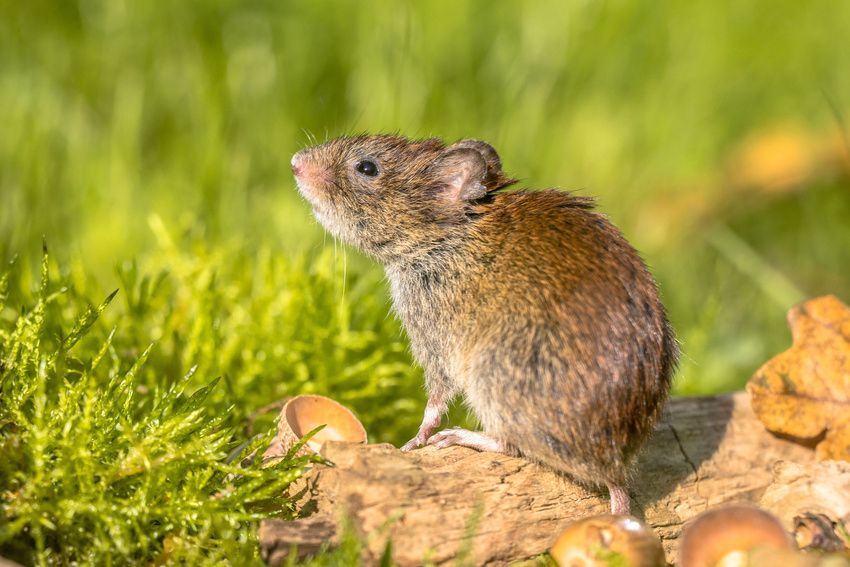
Service Area
Business Hours
- Mon - Fri
- -
- Sat - Sun
- Closed
Saturday Sprays Are Available

Share On: